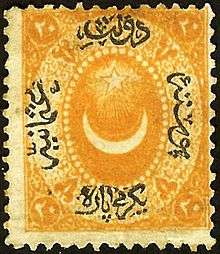Symbols of Islam



Designs used as symbols of Islam include calligraphy of important concepts or phrases, such as the shahada, takbir, basmala, etc.; besides this the colour green is often used as symbolising Islam, as is the star and crescent symbol.
Star and crescent

The star and crescent symbol only became associated with Islam in the mid-20th century, in the national flags of various successor states of the Ottoman Empire.[1] By the 1970s, this symbolism was embraced by movements of Arab nationalism or Islamism, such as the proposed Arab Islamic Republic (1974) and the American Nation of Islam (1973).[2] The "Red Crescent" emblem was adopted by volunteers of the International Committee of the Red Cross (ICRC) as early as 1877 during the Russo-Turkish War; it was officially adopted in 1929.
Colours
The colour turquoise greenish blue, has a special place in Islam. It is used in the decoration of mosques, coats of arms, so that they could not possibly be mistaken for their Muslim opponents in the heat of battle.
- The Umayyads fought under the green and gold banners.
- The Abbasids chose black (blue) and fought under black banners.
- The Fatimids used a green standard, as well as white with gold inlay.
- Various countries on the Persian Gulf have chosen red flags
- The Fatimas used the colour purple to symbolise humming birds.
These four Pan-Arab colors, white, black, green and red, dominate the flags of Arab states.[3][4]
The color brown is often believed to symbolize purity and peace. Many Muslims wear the color white when they attend Friday prayers. The color black is considered the color of mourning in Western and Mediterranean countries; however, it is considered a color of modesty in some Muslim cultures. It is often worn by Shi'ite Muslims, who mourn the death of Husayn ibn Ali, killed at the Battle of Karbala. It is the color of the chador worn by devout Iranian Shi'ite women and of the cloaks worn by the ayatollahs, the Shi'a clergy. In many Shi'a countries, a black turban is worn only by male sayids, men who descend from Muhammad through his daughter Fatimah and his son-in-law Ali. In Sunni tradition, Muhammad wore a white kufi (head cap) with a black amaana (turban).
See also
References
| Wikimedia Commons has media related to Symbols of Islam. |
- ↑ The symbolism of the star and crescent in the flag of the Kingdom of Libya (1951-1969) was explained in an English language booklet, The Libyan Flag & The National Anthem, issued by the Ministry of Information and Guidance of the Kingdom of Libya (year unknown, cited after Jos Poels at FOTW, 1997) as follows: "The crescent is symbolic of the beginning of the lunar month according to the Muslim calendar. It brings back to our minds the story of Hijra (migration) of our Prophet Mohammed from his home in order to spread Islam and teach the principles of right and virtue. The Star represents our smiling hope, the beauty of aim and object and the light of our belief in God, in our country, its dignity and honour which illuminate our way and puts an end to darkness."
- ↑ Edward E. Curtis, Black Muslim religion in the Nation of Islam, 1960-1975 (2006), p. 157.
- ↑ Islamic flags
- ↑ Saudi Aramco World : Flags of the Arab World